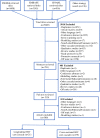Statistical methods applied for the assessment of the HIV cascade and continuum of care: a systematic scoping review
- PMID: 37996221
- PMCID: PMC10668296
- DOI: 10.1136/bmjopen-2022-071392
Statistical methods applied for the assessment of the HIV cascade and continuum of care: a systematic scoping review
Abstract
Objectives: This scoping review aims to identify and synthesise existing statistical methods used to assess the progress of HIV treatment programmes in terms of the HIV cascade and continuum of care among people living with HIV (PLHIV).
Design: Systematic scoping review.
Data sources: Published articles were retrieved from PubMed, Cumulative Index to Nursing and Allied Health Literature (CINAHL) Complete and Excerpta Medica dataBASE (EMBASE) databases between April and July 2022. We also strategically search using the Google Scholar search engine and reference lists of published articles.
Eligibility criteria: This scoping review included original English articles that estimated and described the HIV cascade and continuum of care progress in PLHIV. The review considered quantitative articles that evaluated either HIV care cascade progress in terms of the Joint United Nations Programme on HIV and AIDS targets or the dynamics of engagement in HIV care.
Data extraction and synthesis: The first author and the librarian developed database search queries and screened the retrieved titles and abstracts. Two independent reviewers and the first author extracted data using a standardised data extraction tool. The data analysis was descriptive and the findings are presented in tables and visuals.
Results: This review included 300 articles. Cross-sectional study design methods were the most commonly used to assess the HIV care cascade (n=279, 93%). In cross-sectional and longitudinal studies, the majority used proportions to describe individuals at each cascade stage (276/279 (99%) and 20/21 (95%), respectively). In longitudinal studies, the time spent in cascade stages, transition probabilities and cumulative incidence functions was estimated. The logistic regression model was common in both cross-sectional (101/279, 36%) and longitudinal studies (7/21, 33%). Of the 21 articles that used a longitudinal design, six articles used multistate models, which included non-parametric, parametric, continuous-time, time-homogeneous and discrete-time multistate Markov models.
Conclusions: Most literature on the HIV cascade and continuum of care arises from cross-sectional studies. The use of longitudinal study design methods in the HIV cascade is growing because such methods can provide additional information about transition dynamics along the cascade. Therefore, a methodological guide for applying different types of longitudinal design methods to the HIV continuum of care assessments is warranted.
Keywords: HIV & AIDS; Public health; STATISTICS & RESEARCH METHODS.
© Author(s) (or their employer(s)) 2023. Re-use permitted under CC BY. Published by BMJ.
Conflict of interest statement
Competing interests: ‘Yes, there are competing interests for one or more authors and I have provided a Competing Interests statement in my manuscript and in the box below’
Figures


References
-
- Centers for disease control and prevention (CDC) . Vital signs: HIV prevention through care and treatment--United States; 2011. MMWR. morbidity and mortality weekly report 1618–23. - PubMed
Publication types
MeSH terms
Grants and funding
LinkOut - more resources
Full Text Sources
Medical
Miscellaneous
